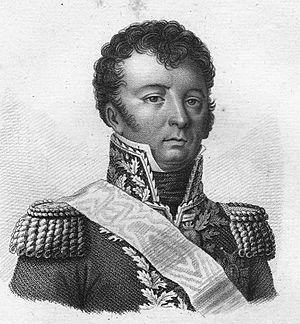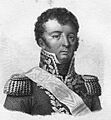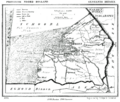Battle of Alkmaar (1799) facts for kids
Quick facts for kids Battle of Alkmaar |
|||||||
|---|---|---|---|---|---|---|---|
| Part of Anglo-Russian invasion of Holland | |||||||
 Général Dominique Joseph René Vandamme |
|||||||
|
|||||||
| Belligerents | |||||||
| Commanders and leaders | |||||||
| Strength | |||||||
| 25,000 | 40,000 | ||||||
| Casualties and losses | |||||||
| 3,000 | 2,200 | ||||||
The Battle of Alkmaar was a big fight that happened on October 2, 1799. It's also known as the Second Battle of Bergen or the Battle of Egmond-aan-Zee. This battle was part of the Anglo-Russian invasion of Holland. It took place near Alkmaar in the Netherlands.
The battle was fought between the armies of French Republic and their allies, the Batavian Republic, against an army from Great Britain and Russia. General Guillaume Marie Anne Brune led the French and Batavian forces. Prince Frederick led the British and Russian forces.
Even though the battle itself didn't have a clear winner, the British and Russians gained a small advantage. This made General Brune decide to pull his troops back the next day. They moved to a new defense line between Monnickendam and Castricum. The final battle of this campaign would happen there on October 6.
Contents
Why the Battle Happened
After the first Battle of Bergen (1799) on September 19, 1799, both armies were in almost the same spots. Bad weather, with heavy rains, stopped any new attacks for a while. The roads became very muddy and hard to use.
The French and Batavian defenders used this time to flood the low-lying eastern part of the North-Holland area. This made their defenses there very strong. Because of this, the British and Russians couldn't attack in those areas anymore.
New Troops Arrive
The delay helped the British and Russian side. About 6,000 more Russian soldiers arrived. British reinforcements also landed around the same time. This meant the British and Russian army now had about 40,000 soldiers. This was a lot more than the French and Batavian forces.
Prince Frederick, the Duke of York, knew that more French troops were coming from Belgium. So, he wanted to use his larger army as soon as possible. His plan was to attack the French and Batavian left side. This part of the army was near Koedijk and between Alkmaar and the sea, around Bergen.
The attack was planned for September 30, but the roads were still too muddy. Soldiers were sinking to their knees! It was then moved to October 1, but had to be postponed again. The battle finally started on October 2.
How the Battle Unfolded
The British and Russian army set up their attack in several groups:
- Right Side Attack: About 8,000 British soldiers, led by General Ralph Abercromby, marched along the beach and sea dike near Petten. Their goal was the village of Egmond aan Zee.
- Center Attack: Two groups of about 8,000 Russian soldiers, led by General Ivan Essen, moved towards Bergen.
- Left Side Attack: About 6,000 British troops, led by Sir Ralph Dundas, were to support the Russians attacking Bergen. They also had to keep in touch with Abercromby's group. Another group was to attack the Batavian soldiers near Schoorldam along the Alkmaar canal.
- Far Left Side: About 7,000 British and Russian soldiers, led by Sir James Pulteney, protected the army's left side. They also looked for chances to get around the French and Batavian troops.
This plan shows that the main attack was again aimed at the village of Bergen. This time, the attack was focused on a smaller area, between Schoorl and the North Sea. General Abercromby was supposed to go around the French left side by advancing along the beach. This was a "single envelopment" plan, meaning they tried to wrap around one side of the enemy.
Early Stages of the Fight
The battle started well for the British. They waited for low tide (around 6:30 AM) so Abercromby's group could use the beach. Soon, British troops pushed French outposts out of the villages of Camp and Groet. They also cleared the sand dunes.
Russian troops then moved forward carefully. Other British and Russian forces pushed the French and Batavian soldiers out of Schoorl and Schoorldam towards Koedijk. The Russians stopped there and fired their cannons at Koedijk and Bergen for the rest of the day.
Fighting in the Dunes
Meanwhile, the French left side had fallen back to the village of Bergen. This was a strong defensive spot. The Duke of York knew they had to take it. He ordered British brigades to attack the French in the dunes near Bergen. They managed to push the French back and make them leave their high positions.
It looked like they were ready to attack Bergen itself. But the Russian general, Essen, seemed unwilling to push the attack. Since the two British brigades weren't strong enough alone, the attack stopped there.
The French saw the Russians hesitate. They launched a strong counterattack from Bergen. British soldiers fought back successfully. The French were driven out of the dunes after a tough fight, but they still held Bergen. The fighting continued until 11 PM, but no more ground was gained.
Abercromby's Beach Advance
While this was happening, Abercromby's group was slowly moving along the beach. The rising tide made the beach narrower, forcing soldiers to march through loose sand. Cavalry had to wade through the waves.
The French soon noticed this advance. They sent sharpshooters who caused many casualties, especially among British officers. Abercromby sent more troops to push them back. But the French also brought in more soldiers. They took a strong position on the dunes overlooking the beach, blocking the British advance.
General Moore tried to attack with bayonets, but the French line held. The fight lasted for hours and was very fierce. Abercromby had two horses killed under him, and Moore was badly wounded. Finally, the British broke through the French defenses. They took control of the road between Bergen and Egmond aan Zee. This cut off the French troops at Egmond aan Zee.
French Counterattack and Retreat
General Brune, who was still at Bergen, ordered General Vandamme to take charge at Egmond aan Zee. He also told General Daendels to send Batavian cavalry and infantry from Alkmaar to help the French.
When Vandamme arrived, he saw that Abercromby's horse artillery had moved too far forward on the beach. He thought he could win the battle by leading a cavalry charge against these guns. However, he didn't expect Lord Paget's dragoons. Paget's cavalry ambushed Vandamme just as he captured the British guns. Paget's dragoons defeated the French cavalry, who retreated all the way to Egmond aan Zee.
As darkness fell, this last action ended the battle. Abercromby decided to stay on the beach for the night. His men and horses were very thirsty because fresh water was hard to find in the dunes. They slept ready for battle, with occasional French cannon fire bothering them.
Aftermath of the Battle
Even though the battle seemed like a small win for the British, it had big consequences. Abercromby had managed to get behind the French left side. This cut off communication between Bergen and Egmond aan Zee.
Because of this, General Brune decided to leave Bergen. The next day, he ordered a full retreat to a new line from Wijk aan Zee to Castricum and Uitgeest. Alkmaar was left empty by the French and Batavian troops. The city opened its gates to the British and raised the orange flag, a symbol of the old Dutch government.
The British and Russian forces lost about 2,200 soldiers, killed or wounded. Many officers were among them. The French and Batavian forces lost about 3,000 soldiers. Some British regiments were later given the honor to display "Egmont op Zee" on their flags.
Next Steps in the Campaign
For a few days, the British felt they were winning. They seemed to control most of the North-Holland area, including its main cities. However, large parts of the area, like the rich farmlands, had been flooded by the Batavian army. This meant the British and Russians couldn't get food from those areas. They still had to get supplies by sea.
Their supply lines from their base at Den Helder also became much longer. The terrible condition of the roads due to bad weather made getting supplies even harder. The Duke of York felt he had to keep pushing his attack towards Haarlem. More French troops were also arriving from Belgium. At the same time, more and more British and Russian soldiers were getting sick.
So, the Duke started a strong scouting mission on October 6. This turned into the Battle of Castricum. The British and Russian army arguably lost this battle. The worsening situation forced the Duke of York to pull his army all the way back to their starting point. After agreeing to a peace deal called the Convention of Alkmaar, the British and Russian forces left the area by November 19, 1799.
Images for kids




